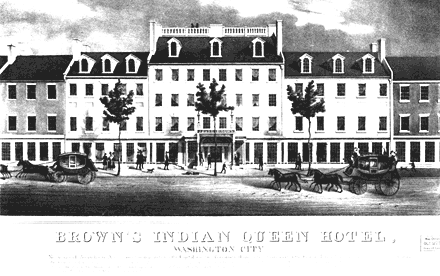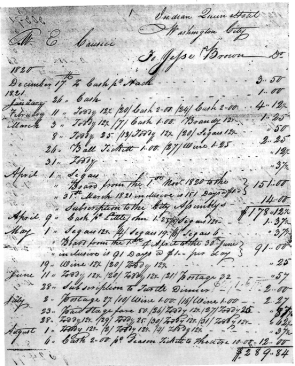
The Record - September 1998
Law West of the Anacostia:
The Case Papers of the U.S.Circuit Court for the District of Columbia
By William A. Dobak
- Notice: Will be sold on Tuesday June 26th 1821 at the central market
house at 7 o'clock a m the following Property to wit Negro Girl by the name
of Mary with a small child about 5 months old Seized and taken by virtue of
two writs... issued out of the Clerks office of Washington County and to me
Directed as the Property of H. Hall at the Suit of William Cox Terms of Sale
Cash June 19th 1821 CM Boteler Constable

Brown's Indian Queen Hotel, Pennsylvania Avenue, Washington, DC.
(Library of Congress)
Washington's Central Market stood on Pennsylvania Avenue between Seventh and Ninth Streets, on the site now occupied by the National Archives building. Across the street from the market, at the corner of Seventh and Pennsylvania, stood the boarding house run by Mrs. Susan Tucker. "On the meeting of Congress I took lodgings in the house," recalled Enoch Lincoln, a representative from the new state of Maine. "The room which I occupied had been apparently but very recently plaistered, & the walls were so damp that, on several times, before I retired to bed, I made a large fire & dried the bed & bed clothes which had absorbed much moisture. The other rooms in the house were in a similar condition & were all affected by smoke from the want of draught of air thro' the chimnies. After I had taken my lodgings, . . . several gentlemen whose names I do not recollect, called at different times, to examine the house & to determine as to becoming boarders in it. The objection generally made ... was that the dampness of the house would be dangerous to the health of the boarders in it."
The announcement of the sale of Mary and her infant, Representative Lincoln's account of rental property during the Era of Good Feelings, and hundreds of other disquieting incidents of everyday life in Washington between 1800 and 1863, are preserved in the records of the United States Circuit Court for the District of Columbia (Record Group 21), now housed in the National Archives, Washington, D.C. The court originated in the organic act of 1801 that established a government for the District of Columbia. At its founding, the District was diamond-shaped and included two counties: Washington, on the Maryland side of the Potomac, and Alexandria, on the Virginia side. Court sessions alternated between the two counties until Alexandria's recession to Virginia in 1846. The court's surviving records that pertain to Alexandria are now in the Library of Virginia, at Richmond, and the National Archives houses documentation of Washington County cases. The U.S. Circuit Court for the District of Columbia continued to meet until 1863, when the Supreme Court of the District of Columbia assumed jurisdiction.
Among the court's records are the "case papers." These are extremely sparse for the first few years, and the surviving documents do not assume much pattern or regularity until about 1809. The main categories of documents are Civil Appearances (the initial stage of a civil suit), Imparlances (continuance for further discussion between parties), Civil Trials, and Judicials (final determination). Until 1838, the U.S. Circuit Court also had criminal jurisdiction, so the case papers contain documents relating to Criminal Appearances and Trials, as well. And each session generated a grab-bag of documents, known as the Rough Bundle, that related to membership in the D.C. Bar, hiring and firing of constables, tavern licenses, apprenticeships, lists of grand and petit jurors for each term, and the grand jury's report on the Washington jail (still spelled "gaol" during the early years). A session's Rough Bundle might contain a dozen licenses to vend liquor at the race track, as well as the grand jury's denunciation of the autumn races, where "Thoughtless and inexperienced" farmers, "who are led to see these sports from curiosity are allured by various arts to the gambling table and there stripped of all the hard earnings of the season, and are thus drawn to drunkenness and idleness themselves, and their families to beggary." (June term 1818.)
Several case-lists are now available at the National Archives in Washington, D.C. to help historians get at this material. These lists have developed during a continuing project in which the case papers are being unfolded, flattened, and placed in acid-free folders and new boxes. At present, the lists are in ring-binders in the Civil Records Reference Room (11E). A proposal to put them on NARA's website is under consideration. The most important of the lists are those concerning black Washingtonians; inventories of seized household goods; tradesmen's accounts that required a lawsuit to collect; and a subject index to the tradesmen's accounts.
Petitions for Freedom
The material also includes a number of cases called Petitions for Freedom,
in which slaves argued that they were being wrongfully held in bondage, due
to some technicality of D.C. law. It was against the law, for instance, to sell
slaves within a year of bringing them to Washington. Black defendants were mostly
involved in theft and receiving stolen property; they do not seem to have had
a prominent role in the gambling and brothel keeping that figured so largely
in Washington criminal proceedings. Sometimes the offenses were more momentous,
though. On October 10, 1825, "negro Abraham Williams ... did aid and assist
one negress Mary the slave of one William L. Brent, in her endeavor to escape
from the service of her master. . . ." (May term 1826, Criminal Appearances
19)
(NARA, RG 21, Records of the District Courts of the U.S., Case Papers of the U.S. Circuit Court for the District of Columbia, December term 1826, Civil Trial 247)
There are also numerous case files containing inventories of household goods that had been seized for debt. Although most of these name the articles in no particular order, as they might have been stacked on the sidewalk before being hauled away, a few are room-by-room inventories of the sort that might be useful to museum curators. The case list of inventories includes other goods, too, besides domestic furniture: a blacksmith's tools, a hatter's tools, a livery stable and its equipment, a set of telescopes and scientific instruments, and a tradesman's stock of thirty-two umbrellas of various colors and sizes.
The case papers also contain numerous accounts of goods and services that required lawsuits to collect. The most spectacular of these, no doubt, were the two brought by the Nicoll Brothers and Stephen Vail, outfitters of the ocean-going steamer Savannah, who had to sue the vessel's owner to collect for hardware, cordage, sails, spars, and the hull of the ship itself. (June term, 1820, Civil Appearances 364 and 431) The file for each case contains an itemized list of the material each outfitter supplies, and its cost: $8274 in the suit brought by the Nicolls; $19,510 in Vail's case.
"And each session generated a grab-bag of documents, known as the Rough Bundle..."
Other case files give some comparative idea of what those figures mean, for they show that a laborer's daily wage was only about a dollar or $1.25. Piecing together information from several cases, one can learn the cost of shipment of a load of flour from the Shenandoah Valley to Washington, and of a load of grain from Georgetown to Antigua, and the ship's return with a cargo of West Indian sugar, in the days when Alexandria and Georgetown were deep-water ports, and served as entrepots for the agricultural products of a vast region. (June term, 1813, Civil Appearances 336; December term 1814, Civil Trials 127)
A subject index to the tradesmen's and artisans' accounts is also available in the Civil Records Reference Room. Cases are arranged by subject, then chronologically by court term and then by kind of case and docket number: for instance, Alcohol (whether sale by the gallon, or somebody's bar tab), June term 1817: Civil Appearances 439; Civil Trials 152, 177, 325; Imparlances 18. Or Firewood and Coal, October term 1821: Civil appearances 395; Civil Trials 19; Judicials 59. Historians interested in what it cost James Monroe's contemporaries to keep warm can jot down these citations, consult the box list for the case papers, which gives the number of the container that holds a particular case file, and fill out a pull slip in order to retrieve the documents. The categories in the index with the most entries are alcohol (173 entries through the December term of 1829), artisans' labor and professional services (218 entries), cloth (182) and groceries (186), with clothing (mostly tailors' bills, in an age before ready-to-wear), hardware (blacksmiths' bills, as often as not) and lumber close behind.
It has been more than thirty years since Constance M. Green published The Secret City: A History of Race Relations in the Nation's Capital, and even longer since the appearance of her Washington: Village and Capital, 1800-1878 (1962), Richard Wade's Slavery in the Cities (1964) and James S. Young's The Washington Community, 1800-1828 (1966). These three decades have seen vast changes in the way historians approach their subject. The material contained in the case papers of the U.S. Circuit Court for the District of Columbia should prove invaluable to those who study everyday life in Washington, and throughout the Mid-Atlantic States, during the early nineteenth century.
William A. Dobak received a Ph.D. in American Studies from the University of Kansas in 1995. He now works at the National Archives in Washington, DC.